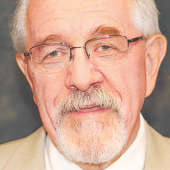- Christmas shopping is done, presents wrapped, strings attached? (12/14/16)
- Cecil is dead and human lives are threatened every day (8/12/15)
- As state flags go, Nebraska's ranks 50th (7/8/15)
- When everything looks like a nail (4/29/15)
- Who remembers to coal slurry pipeline debate? (3/11/15)
- More revelations in Department of Corrections mess (12/17/14)
- The Legislature becomes more Republican (11/19/14)
Opinion
Russell Means: Accusations, allegations and acquittal
Wednesday, December 5, 2012
EDITOR'S NOTE: Native American activist Russell Means died Oct. 22 at his home near Porcupine, South Dakota. The 72-year-old was no stranger to Nebraskans and once said he thought it would be safer to be a dog in a Nebraska community that bordered the Indian reservation than to be a Native American. Capitol Correspondent J.L. Schmidt met Means 39 years ago and often reported on incidents involving the flamboyant spokesman for the American Indian Movement. Schmidt takes a look at Means' involvement and what it meant to the Native American culture.
Indian activist Russell Means, who died at his ranch near Porcupine, South Dakota, on Oct. 22, was one of the young American Indian Movement leaders who became the face of the 71-day siege of Wounded Knee in February 1973.
Means, who had become well known by Nebraskans after incidents in Gordon and Scottsbluff in the months leading up to the takeover, was joined by Dennis Banks and Clyde and Vernon Bellecourt of Minnesota, all AIM leaders, in pushing the cause for justice for traditional Native Americans whom -- they claimed -- were being overlooked by the federal government and the Pine Ridge Reservation government led by President Richard Wilson and his "goon squad."
The young AIM warriors -- Means was 32 at the time -- were like a breath of fresh air to the Indian people, and their ideas quickly caught on. More than 75 different Indian Nations were represented during the occupation with more arriving daily from all over the country. United States Armed Forces in the form of Federal Marshals and the National Guard surrounded the large group. Nearly 300 officers from the Bureau of Indian Affairs were also there and Wilson's goons set up another level of "protection." All roads to Wounded Knee were cut off, but still, people slipped through the lines, pouring into the occupied area.
Means and company demanded an investigation: into misuse of tribal funds; the goon squad's violent aggression against opponents of the tribal government; and a Senate investigation into the BIA and the Department of the Interior regarding their handling of the affairs of the Oglala Sioux Tribe. Means contended that the United States had broken 371 treaties between the Native Nations and the Federal Government.
The government responded by cutting off the electricity to Wounded Knee and attempting to keep food supplies from entering the area. The AIM-led group spent the rest of the winter living on minimal resources while they fought the armed aggression of Federal Forces. Daily, heavy gunfire became the norm. AIM members Buddy Lamont and Frank Clearwater were killed by fire from an M16 and a machine gun. Twelve others were intercepted by the goon squad while back packing supplies into Wounded Knee. They disappeared and were never heard from again. One FBI agent was shot and paralyzed and died. A black activist who joined the Natives disappeared and his body was never found. Two more FBI agents were killed after the siege during violence that continued to broil. Female AIM member Anna Mae Aquash was killed and authorities think it was an AIM hit because some believed she was a government spy.
On March 10, the Government took down their roadblocks. They hoped the Indians would leave, but the Indians saw it as a victory and strengthened their position. Hundreds of supporters poured into Wounded Knee with food and medical supplies. The next day, AIM and the Oglala Sioux elders declared the rebirth of the Independent Oglala Nation.
On March 26, the phone lines were cut and the mainstream media left. The FBI started rounding up and arresting supporters nation-wide.
On May 4, the White House sent the Indians a letter promising that White House representatives will meet with the Sioux chiefs to discuss the Fort Laramie Treaty. The Indians agree to end their occupation. Over 150 people leave Wounded Knee, slipping past roadblocks with their weapons. The Nixon White House quickly breaks its word, saying, "The days of treaty making with the American Indians ended in 1871, 102 years ago."
After 71 days, the Siege at Wounded Knee had come to an end, with the government making nearly 1,200 arrests. But this would only mark the beginning of what the Native called the "Reign of Terror" instigated by the FBI and the BIA. During the three years following Wounded Knee, 64 tribal members were unsolved murder victims, 300 harassed and beaten, and 562 arrests were made, and of these arrests only 15 people were convicted of any crime. The Honorable U.S. Judge Warren Urbom of Lincoln conducted the federal trials in the old federal building near the historic Lincoln Haymarket. Things remained quiet for years.
But, problems of alcohol abuse among the natives on the dry reservation and the close proximity of bars and liquor stores in Nebraska made headlines again in the last decade. The death of Means provides another opportunity to discuss the issues that he originally brought to light almost 40 years ago.

